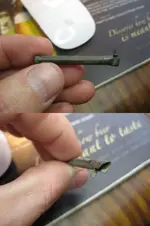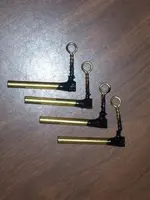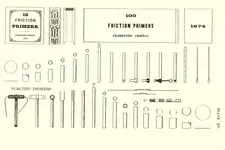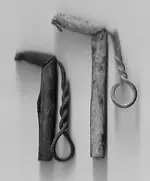DirtDigler wrote:
> I spoke with Randy Klemm, Curator of the American Civil War Museum in Richmond and several others and
> here is what I found. [Deleted only for brevity.] The design manuafactured in the North [deleted only for brevity].
> The designers in the South took the main tube and cut a short slit down one side of the tube and after applying
> the priming paste inside the tube, ran the friction wire down inside the tube and wedged it into the slit, bending it
> at a 90-degree angle.
In reply #19 of this discussion, written back in May, I told DirtDigler that I would post photos a battlefleld-excavated Confederate-made cannon friction-primer which seems to match the museum curator's description. I apologize for the long delay. I do not have a digital camera. My wife recently got us a new scanner, so I'm now able to make a scan of the Confederate-made primers I was talking about. Here they are. These are un-used. (Used ones are missing their twisted-wire loop, which was pulled out by the gunner's lanyard, to fire the cannon.)
This specific form/shape of civil war friction primer was manufactured only by the Confederates. A slit or notch was cut into the tube, about 3/4" from its top, and that part was folded down at a 90-degree angle (or a bit less), to close the opening in the tube's side. Then a small hole was drilled into the tube's side, just below the fold, and then a serrated wire (whose end was twisted to form a loop) was insted into the hole, penetrating all the way to the short end of the tube. The entire tube was then filled with "friction-compound," a chemical compound which is similar to a match's head.
For any readers here who do not know how a civil war era cannon friction-primer "worked":
To fire a cannon, the gunner would insert the long end of the friction-primer into the cannon's vent-hole (also called a touch-hole), located at the cannon's breech end (the fat end of the cannon). The vent-hole goes down through the cannon's thick metal walls to where the powder-charge is located. When the gunner's lanyard quickly jerked the serrated wire out of the tube's friction-compound, the compound ignited like a flaring match-head, creating a jet of flame which ignited the cannon's powder-charge.
 These things...
These things... These things...
These things...








